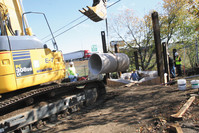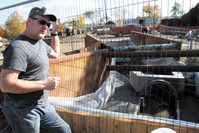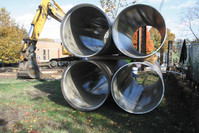While traffic never slowed down and there wasn’t as much as a single detail policeman or detour sign, a new section of sewer line – the “Achilles heel” to the city’s sewer system, as Janine …
This item is available in full to subscribers.
We have recently launched a new and improved website. To continue reading, you will need to either log into your subscriber account, or purchase a new subscription.
If you are a current print subscriber, you can set up a free website account by clicking here.
Otherwise, click here to view your options for subscribing.
Please log in to continue |
|



While traffic never slowed down and there wasn’t as much as a single detail policeman or detour sign, a new section of sewer line – the “Achilles heel” to the city’s sewer system, as Janine Burke-Wells describes it – was installed last week across Route 95.
What’s more, people kept flushing toilets, taking showers and running their washing machines for a daily total of 4.5 million to 5 million gallons of wastewater. It was just what Burke-Wells, the executive director of the Warwick Sewer Authority, had hoped for.
Replacing a concrete pipe that was installed before the interstate highway was built was a matter of putting a pipe within a pipe without impeding the flow. Actually doing the installation for the segment under Route 95 took a couple of days. The engineering and the preparation took far longer.
The work started with cutting off a section of the top half of the existing 48-inch pipe at either end to expose the flowing wastewater. The new pipe, a one-inch-thick fiberglass composite that is 42 inches in diameter, was then lowered into the cut of the original pipe in sections and pushed upstream to the open end on the east side of 95. Before the process was started, a steel cylinder the size of the new pipe was pulled through the line to ensure it was clear of anything that might snag the new pipe such as exposed rebar or reinforcement steel rod used in the original pipe. With the pipe clear of obstructions yet continuing to carry the full flow of the city’s collection system, the new sections were prepared for installation with a coating of epoxy at the joints of each pipe. A collar was then fitted to the section of new pipe to prevent any damage to the new pipe and the claw of a backhoe used to push it into place.
Sewer Authority board member Peter Ginaitt was present Thursday as the final sections of pipe were lowered into place to complete that section under Route 95.
The next step, explained project representative Robert Fougere with Brown and Caldwell, is to fill the void between the old and new pipes. He said foam grout that starts off with the consistency of water will be injected between the two pipes. The grout will harden to form a bond between the two pipes.
With the 650-foot section under Route 95 completed, the next phase of the project is to extend the new pipe to tanks within the treatment plant site. Fougere estimated that work would be completed by Nov. 11, with site restoration remaining.
R. Zappo of Stoughton, Mass. is performing the work under a $753,902 contract. Funding will come from the industrial pre-treatment fund that currently stands at about $1 million.
Burke-Wells described the project as essential preventative maintenance. Had the original pipe been allowed to deteriorate to the point it was “out of round,” the slip-sleeve method used wouldn’t have worked, driving up costs and conceivably resulting in the interruption of plant operations. Because of its smooth surface, the inner lining pipe is projected to handle a greater flow than the wider old pipe. As for the capacity to meet future demand with the extension to the sewer system, Burke-Wells said in a recent interview that while the average daily flow was 5.3 million gallons with 16,000 customers nine years ago, today that has dropped to 4.7 million gallons with an additional 5,700 customers. She attributes the reduction to water conservation and identification of leaks within the system with one of the largest being the Cedar Swamp pumping station.
“We must have been pumping half of Buckeye Brook,” she said.
“This is where you’re vulnerable,” she said, pointing to the pipe feeding the plant and looking up at the stream of Route 95 traffic just above the embankment.
Observing the steady stream of incoming wastewater, Ginaitt facetiously suggested the city might have a new source of tourism revenue with kayak tours of the sewer system. Burke-Wells thought that would be too claustrophobic, but then she had another idea – hydropower. She said inside pipe generators have been developed and are being used in other parts of the country. She plans to check them out next.
Comments
No comments on this item Please log in to comment by clicking here